Contents
| |||||
| Decades: | |||||
|---|---|---|---|---|---|
| See also: | Other events of 1707 List of years in Spain | ||||
Events from the year 1707 in Spain.
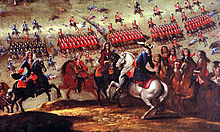
| |||||
| Decades: | |||||
|---|---|---|---|---|---|
| See also: | Other events of 1707 List of years in Spain | ||||
Events from the year 1707 in Spain.

The Capetian dynasty, also known as the House of France, is a dynasty of Frankish origin, and a branch of the Robertians agnatically, and the Karlings through female lines. It is among the largest and oldest royal houses in Europe and the world, and consists of Hugh Capet, the founder of the dynasty, and his male-line descendants, who ruled in France without interruption from 987 to 1792, and again from 1814 to 1848. The senior line ruled in France as the House of Capet from the election of Hugh Capet in 987 until the death of Charles IV in 1328. That line was succeeded by cadet branches, the Houses of Valois and then Bourbon, which ruled without interruption until the French Revolution abolished the monarchy in 1792. The Bourbons were restored in 1814 in the aftermath of Napoleon's defeat, but had to vacate the throne again in 1830 in favor of the last Capetian monarch of France, Louis Philippe I, who belonged to the House of Orléans. Cadet branches of the Capetian House of Bourbon are still reigning over Spain and Luxembourg.
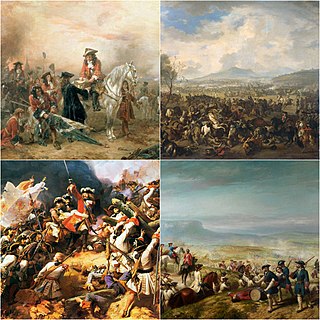
The War of the Spanish Succession was a European great power conflict fought between 1701 and 1714. The immediate cause was the death of the childless Charles II of Spain in November 1700, which led to a struggle for control of the Spanish Empire between supporters of the French Bourbons and the Austrian Habsburgs. Charles had named as his heir Philip (Bourbon) of Anjou, a grandson of Louis XIV of France, whose claim was backed by France and most of Spain. His rival, Archduke Charles (Habsburg) of Austria, was supported by the Grand Alliance, whose primary members included Austria, the Dutch Republic, and Great Britain. Significant related conflicts include the Great Northern War (1700–21) and Queen Anne's War (1702–13).

1707 (MDCCVII) was a common year starting on Saturday of the Gregorian calendar and a common year starting on Wednesday of the Julian calendar, the 1707th year of the Common Era (CE) and Anno Domini (AD) designations, the 707th year of the 2nd millennium, the 7th year of the 18th century, and the 8th year of the 1700s decade. As of the start of 1707, the Gregorian calendar was 11 days ahead of the Julian calendar, which remained in localized use until 1923.

The House of Bourbon is a dynasty that originated in the Kingdom of France as a branch of the Capetian dynasty, the royal House of France. Bourbon kings first ruled France and Navarre in the 16th century. A branch descended from the French Bourbons came to rule Spain in the 18th century and is the current Spanish royal family. Further branches, descended from the Spanish Bourbons, held thrones in Naples, Sicily, and Parma. Today, Spain and Luxembourg have monarchs of the House of Bourbon. The royal Bourbons originated in 1272, when Robert, the youngest son of King Louis IX of France, married the heiress of the lordship of Bourbon. The house continued for three centuries as a cadet branch, serving as nobles under the direct Capetian and Valois kings.
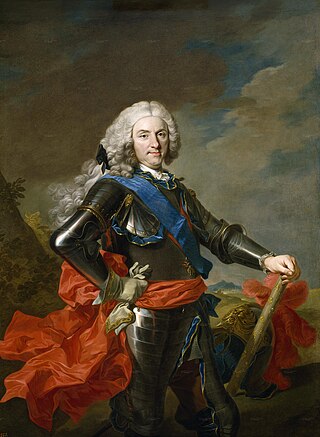
Philip V was King of Spain from 1 November 1700 to 14 January 1724 and again from 6 September 1724 to his death in 1746. His total reign is the longest in the history of the Spanish monarchy, surpassing Philip IV. Although his ascent to the throne precipitated the War of the Spanish Succession, Philip V instigated many important reforms in Spain, most especially the centralization of power of the monarchy and the suppression of regional privileges, via the Nueva Planta decrees, and restructuring of the administration of the Spanish Empire on the Iberian Peninsula and its overseas regions.

The Battle of Almansa took place on 25 April 1707, during the War of the Spanish Succession. It was fought between an army loyal to Philip V of Spain, Bourbon claimant to the Spanish throne, and one supporting his Habsburg rival, Archduke Charles of Austria. The result was a decisive Bourbon victory that reclaimed most of eastern Spain for Philip.
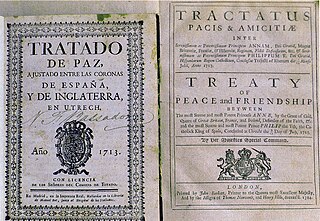
The Peace of Utrecht was a series of peace treaties signed by the belligerents in the War of the Spanish Succession, in the Dutch city of Utrecht between April 1713 and February 1715. The war involved three contenders for the vacant throne of Spain, and involved much of Europe for over a decade. Essentially, the treaties allowed Philip V to keep the Spanish throne in return for permanently renouncing his claim to the French throne, along with other necessary guarantees that would ensure that France and Spain should not merge, thus preserving the balance of power in Europe.

James FitzJames, 1st Duke of Berwick was a French Royal Army officer and nobleman who was the illegitimate son of James II of England by Arabella Churchill, the sister of John Churchill, 1st Duke of Marlborough. Berwick was a successful general in the service of Louis XIV.
A personal union is a combination of two or more monarchical states that have the same monarch while their boundaries, laws, and interests remain distinct. A real union, by contrast, involves the constituent states being to some extent interlinked, such as by sharing some limited governmental institutions. Unlike a personal union, in a federation or a unitary state, a central (federal) government spanning all member states exists, with the degree of self-governance distinguishing the two. The ruler in a personal union does not need to be a hereditary monarch.
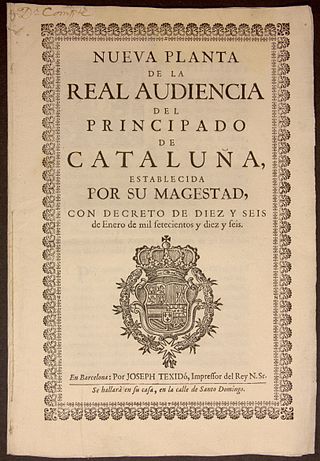
The Nueva Planta decrees were a number of decrees signed between 1707 and 1716 by Philip V, the first Bourbon King of Spain, during and shortly after the end of the War of the Spanish Succession by the Treaty of Utrecht.

Philip was Duke of Parma from 18 October 1748 until his death in 1765. A Spanish infante by birth, he was born in Madrid as the second son of King Philip V and Queen Elisabeth. He became Duke of Parma as a result of the 1748 Treaty of Aix-la-Chapelle. The duchy had earlier been ruled by Philip's elder brother, the future Charles III of Spain, and by their maternal ancestors. Philip founded the House of Bourbon-Parma, a cadet line of the House of Bourbon. He was a first cousin and son-in-law of the French king Louis XV.

The Battle of Almenar also referred to as Almenara was a battle in the Iberian theatre of the War of the Spanish Succession.

The Battle of Saragossa, also known as the Battle of Zaragoza, took place on 20 August 1710 during the War of the Spanish Succession. A Spanish Bourbon army loyal to Philip V of Spain and commanded by the Marquis de Bay was defeated by a Grand Alliance force under Guido Starhemberg. Despite this victory, which allowed Philip's rival Archduke Charles to enter the Spanish capital of Madrid, the allies were unable to consolidate their gains. Forced to retreat, they suffered successive defeats at Brihuega in November and Villaviciosa in December, which effectively ended their chances of installing Archduke Charles on the Spanish throne.
Events from the year 1707 in Ireland.
The following is the Jacobite line of succession to the English and Scottish thrones as of the death of Anne, Queen of Great Britain, on 1 August 1714. It reflects the laws current in England and Scotland immediately before the Act of Settlement 1701, which disqualified Catholics from the throne.
Events from the year 1707 in the Kingdom of England, then England.
Events from the year 1701 in France.
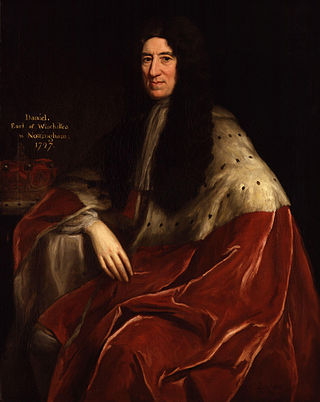
No Peace Without Spain was a popular British political slogan of the early eighteenth century. It referred to the ongoing War of the Spanish Succession (1701–1714) in which Britain was a leading participant. It implied that no peace treaty could be agreed with Britain's principal enemy Louis XIV of France that allowed Philip, the French candidate, to retain the Spanish crown. The term became a rallying cry for opposition to the Tory government of Robert Harley, Earl of Oxford and the terms of the Treaty of Utrecht.

The Kingdom of Spain entered a new era with the death of Charles II, the last Spanish Habsburg monarch, who died childless in 1700. The War of the Spanish Succession was fought between proponents of a Bourbon prince, Philip of Anjou, and the Austrian Habsburg claimant, Archduke Charles. After the wars were ended with the Peace of Utrecht, Philip V's rule began in 1715, although he had to renounce his place in the succession of the French throne.